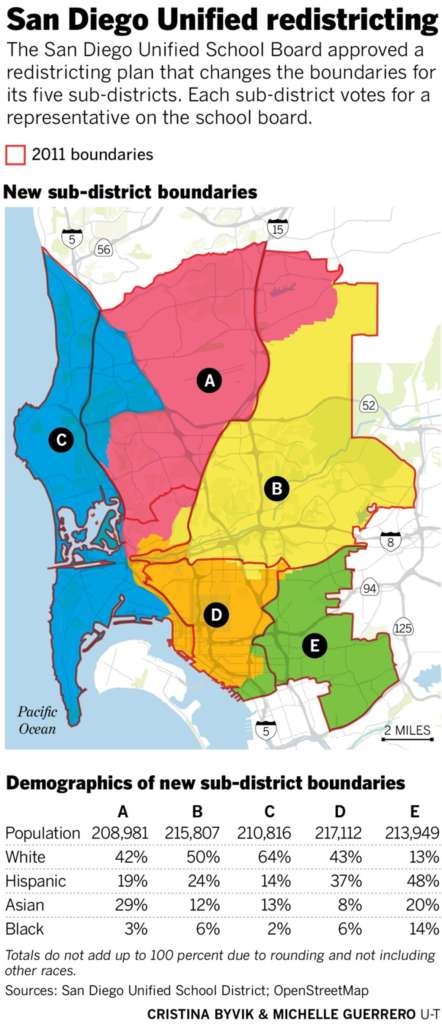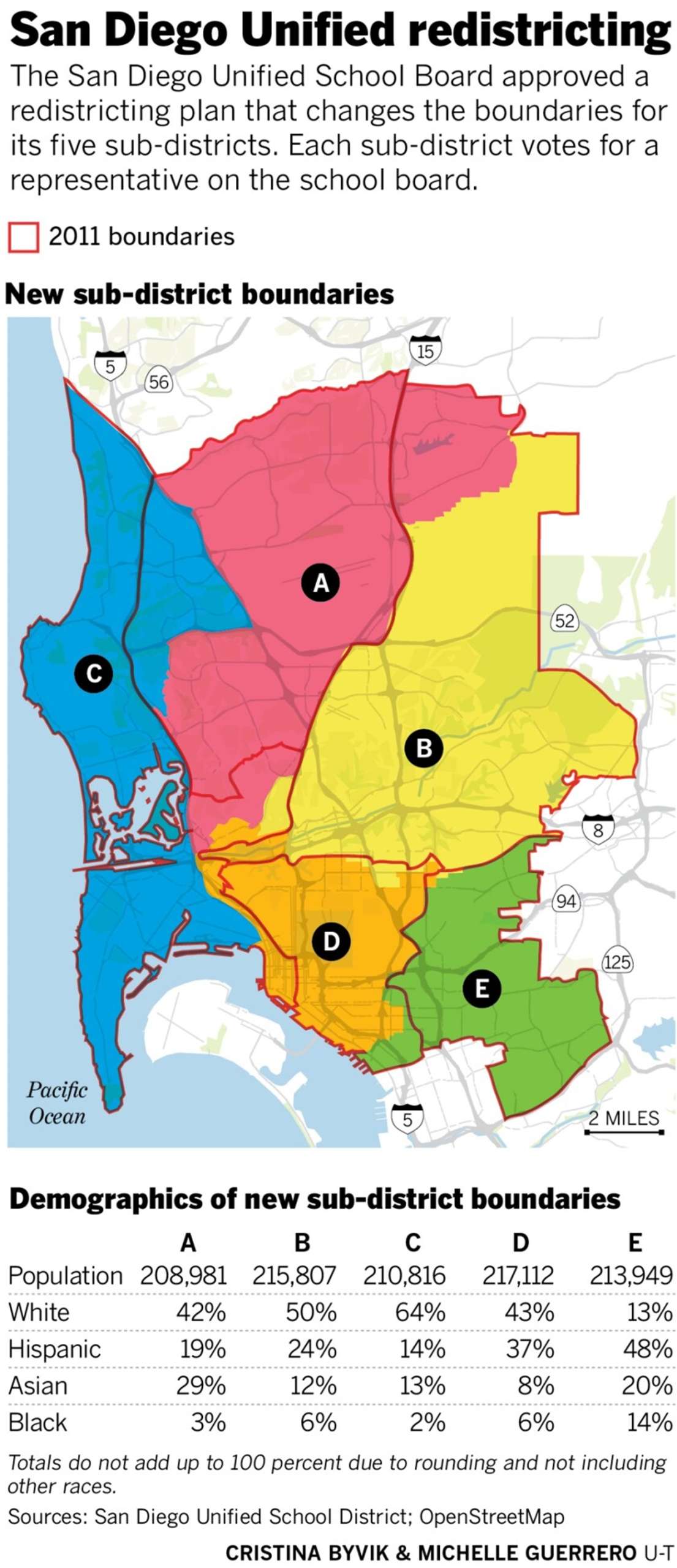San Diego Unified approves redistricting map meant to increase racial minorities’ representation
San Diego Union-Tribune Article: https://www.sandiegouniontribune.com/news/education/story/2021-12-14/san-diego-unified-approves-redistricting-map-designed-to-increase-racial-minority-representation
DEC. 14, 2021 9:27 PM PT
The San Diego Unified School Board unanimously approved a redistricting plan Tuesday that shifts boundaries around neighborhoods to create a majority of people of color in one additional voting area.
“It’s going to provide for a better balanced plurality of the ethnic groups across the district,” said School Board Trustee Sabrina Bazzo at a board meeting Tuesday.
The plan, which was recommended by a board-appointed redistricting committee, moves Scripps Ranch from sub-district B to sub-district A, while moving University City from sub-district A to sub-district C.

The move upset some community leaders in Scripps Ranch, which now will have to wait three years before voting for a school board representative. Scripps Ranch, which has historically been in sub-district B, would have been able to vote next year under the old district boundaries.
School board members have said that politics and the timing of elections are not supposed to be considered when deciding how to redistrict. School Board Trustee Sharon Whitehurst-Payne and other trustees said Tuesday the board should be looking out for the district as a whole, not one sub-district over another.
“If we’re not lifting up all the students, then we’re doing a disservice to all the students,” Bazzo said.
San Diego Unified is divided into five sub-districts, each of which elect a representative to the five-member school board. Board members serve staggered four-year terms.
About 58 percent of residents living in San Diego Unified are people of color, while 42 percent are non-Hispanic White people, according to the 2020 U.S. Census.
Before redistricting, three of San Diego Unified’s five sub-districts had a majority of people of color: A in north-central San Diego, D in south-central San Diego, and E in southeastern San Diego.
The redistricting plan changes the population of sub-district B, in northeastern San Diego, to give it a population that consists mostly people of color, redistricting committee members have said.
Before redistricting, sub-district B was 53 percent non-Hispanic White; now it’s 49.95 percent non-Hispanic White, according to 2020 census data.
Redistricting entities must ensure that the population totals of voting sub-districts are as equal as possible, that sub-districts are compact and contiguous, that minorities are fairly represented and that “communities of interest” are kept together, according to experts at ARCBridge, the consulting firm that San Diego Unified hired to draw proposed redistricting maps. While minorities must be fairly represented, race is not supposed to be the predominant factor in redistricting, said Priti Mathur, a principal at ARCBridge who has worked in redistricting and census data analysis for more than 25 years, during a redistricting committee meeting last month.
ARCBridge initially drafted three maps for the redistricting committee to review. The firm also noted that San Diego Unified could keep its boundaries the way they were.
ARCBridge’s initial proposed maps would have had two majority White sub-districts out of five. During a redistricting committee meeting last month, ARCBridge said that makes sense, considering the district’s population is about two-fifths White.
“Given this kind of demographic composition of the San Diego Unified School District, it seems fair enough to have two non-Hispanic White districts and three which are minority-plurality districts,” Mathur said during a Nov. 21 redistricting committee meeting.
Some committee members disagreed.
“So, it doesn’t make sense to me, because we’re talking about a plurality of ethnicities, right, so to move from plurality to majority in two districts is a significant shift,” Andrea Guerrero, redistricting committee member and executive director of Alliance San Diego, told Mathur during the Nov. 21 meeting.
The committee told ARCBridge to create a fourth majority-minority sub-district, because the district’s student population — which is not prescribed by state law as a criterion for redistricting — is comprised of more people of color than the general population. San Diego Unified’s student body is 24 percent White and 76 percent students of color.
Sub-district voting is more important than before. Last year voters approved a ballot measure that makes all San Diego Unified School Board trustee elections by sub-district only. Previously residents voted for their own sub-district representative in the primary, then they could vote in all five sub-district elections during the general. Now, voters can only vote for the representative of their own sub-district in both the primary and general elections.
